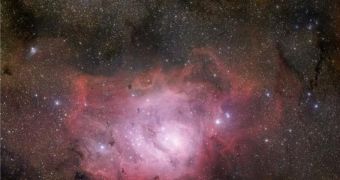The European Southern Observatory (ESO) has finally released its third and final map of the Milky Way, as part of the GigaGalaxy Zoom project. The last image completes the first two nicely, and provides would-be explorers and astronomers with the necessary tools they need to understand which cosmic bodies are which in the night sky. All the pictures that were included in the new panorama were taken with an amateur telescope, and look precisely as the sky is seen with the unaided eye from one of the most suitable places for astronomical observations in the world, the La Silla Observatory, in Chile.
The main instrument used for the panorama was the Wide Field Imager, attached to the MPG/ESO 2.2-meter telescope at the site. The newly imaged structure is the Lagoon Nebula, which was captured in a 370-million-pixel photo that can be used by professional and amateur astronomers alike, in their quest to understanding the Universe. The third installment of the project covers an area eight times larger than that of the full Moon, as seen on the night sky – an area roughly equivalent to one and a half square degrees. The structure is about 4,000 to 5,000 light-years away, in the constellation of Sagittarius.
“The GigaGalaxy Zoom project’s dedicated website has proved very successful, drawing hundreds of thousands of visitors from all around the world. With the trilogy now complete, viewers will be able to explore a magnificently detailed cosmic environment on many different scales and take a breathtaking dive into our Milky Way,” Project Coordinator Henri Boffin says. The initiative was launched to celebrate the International Year of Astronomy 2009 (IYA2009), ESO announced. Its sites in Chile are the most prolific in the world, as they benefit from clearer skies, and from very few atmospheric influences.
The Lagoon Nebula was chosen to be the target of the new observations because it presented a number of interesting features. In its lower-left portion, astronomers have discovered the young, open stellar cluster known as NGC 6530, which is home to between 50 and 100 young, blue stars that make this section of the nebula twinkle. Astronomer Edward Emerson Barnard was the first one to identify and catalog most clouds and globules in the Lagoon Nebula. “The vision of the IYA2009 is to help people rediscover their place in the Universe through the day- and night-time sky, and this is exactly what the GigaGalaxy Zoom project is all about,” Boffin concludes, quoted by AlphaGalileo.
The first two images can be viewed here (interactive Milky Way map) and here (details of our galaxy's core).

 14 DAY TRIAL //
14 DAY TRIAL //